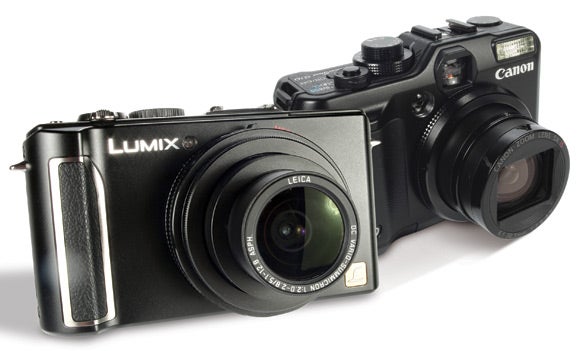Panasonic Lumix LX3 vs Canon PowerShot G10 – Features
Panasonic Lumix LX3 vs Canon PowerShot G10 – Features
While both the Canon G10 and the Panasonic LX3 offer similarly impressive, high-end specifications that dwarf most other compact cameras on the market, there is enough differentiation within the pair’s specification to view them in isolation. To begin with, it’s clear that Canon and Panasonic have taken very different approaches to how best specify an advanced compact’s sensor.
Canon has no real concerns about cramming a relatively large amount of megapixels onto a relatively small sensor, as the Canon G10 boasts a 1/1.7in CCD sensor with an effective 14.7MP count. Perhaps weary of the perils that a combination of high megapixels and small sensors can present, or merely happy to take a step back from the megapixel race, Panasonic has adopted an entirely different approach – not only does the Panasonic LX3 have a sensor that boasts
fractionally more real estate, measuring in at 1/1.63in, but also has
an effective megapixel count of 10.1MP, over 4MP less than the Canon.
The Canon G10 and Panasonic LX3 also vary fairly dramatically with regards to lens implementation as well. Canon opts for a 5x optical zoom with the G10, offering a 28-140mm equivalent focal range and a maximum aperture of f/2.8-5. Alternatively, Panasonic utilises its ongoing partnership with Leica to incorporate a Leica 3x optical zoom with the LX3, one which offers a 24mm wide angle and equivalent focal range of 24-60mm. What’s unique about the lens on the LX3 is that it offers a maximum aperture of f/2-2.8 – one that is exceptional amongst its class and affords lots of creative options including quicker shutter speeds at lower ISO settings and a shallower depth of field.
So, with the major differences between the pair established, it’s worth considering
the similarities. Both the G10 and LX3 offer 3in LCD screens with an impressive 460k-dot resolution, albeit with the G10 also offering a small viewfinder as an accompaniment, and both of the aforementioned lenses are bolstered by optical image stabilisation.
As you’d hope from a camera that’s competing for your attention amongst its DSLR rivals, both the G10 and the LX3 offer full manual control over shutter and aperture, alongside scene modes and auto capture, while offering Raw image capture for those looking to take on the task of post-production.
Despite these similarities, there are still further differences between the pair. For example, while both models offer motion picture output, only the LX3 does at 1080p Full HD quality, complete with a direct HD output. The pair also offer differing ISO sensitivity – The Canon G10 offers ISO sensitivity from 80-1600, while the Panasonic LX3 offers a greater range from ISO 80-3200, with the option of an increased ISO up to 6400 at a reduced resolution.
One nice feature of both models is the range of accessories you can add to the pair. For example, Canon’s G10 is compatible with a range of the brand’s Speedlite flashguns, while a conversion lens adapter can also be fitted to allows for a tele-convertor to be fitted to the lens, in turn increasing the focal range of the camera. Panasonic’s LX3 offers a similar array of accessories – a conversion lens adaptor allows the attachment of a wideangle lens convertor, while an external optical viewfinder can be added via the camera’s hotshoe, or alternatively use the hotshoe for the conventional external flashgun.





